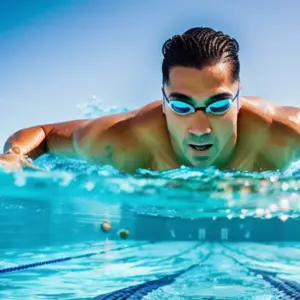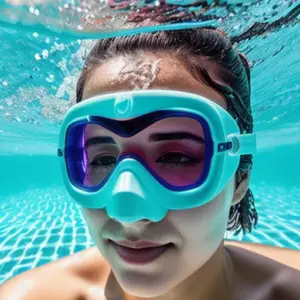Swimming after getting a new ear piercing can pose several risks for infection, as both swimming pools and natural bodies of water contain harmful bacteria and germs. While experts recommend waiting at least 24 hours after getting a piercing before you go swimming, it is best to wait until your piercing is completely healed to minimize the chances of infection. However, if you need to swim before it is fully healed, there are several methods you can use to ensure your piercing is protected while you enjoy the water.
Covering your ear piercing is essential to avoid contact with water and potential infections. One of the most effective ways to cover an ear piercing for swimming is by using a waterproof bandage specifically designed to seal wounds from water. Another option is to wear a swimming cap that covers the ears, offering additional protection alongside the bandage. For individuals wanting extra security, a neoprene headband can also be worn to protect the area. By utilizing these preventative measures and properly caring for your piercing after swimming, you can help promote a safe and healthy healing process for your new ear jewelry.
Avoiding Swimming with Fresh Ear Piercings
When you have a new ear piercing, it’s essential to keep it clean and dry to promote proper healing. One activity you may need to avoid for a while is swimming since water bodies like pools, lakes, and oceans can harbor bacteria, which can lead to infections. Ideally, you should wait until your ear piercings are fully healed before swimming, which typically takes six to eight weeks.
However, if you must swim with fresh ear piercings, there are a few precautions you can take to minimize the risk of infection. One option is to cover your piercing with a waterproof bandage to protect the area from water exposure. Ensure that the bandage completely covers the piercing and is securely attached.
Another solution is to wear a swimming cap that covers the ears. Make sure to purchase a cap specifically designed to protect the ears, as some may not offer adequate coverage. If you want extra security, consider using a neoprene ear band in addition to the swimming cap.
Regardless of what method you choose, it’s crucial to maintain a proper aftercare routine for your ear piercing, even when swimming. After exiting the water, clean the area with a gentle liquid soap and follow your regular aftercare routine. By doing so, you can enjoy swimming without compromising the health and safety of your new piercing.
How Long to Wait Before Swimming with a New Ear Piercing
When you get a new ear piercing, it’s essential to take proper care of it to avoid infections and ensure proper healing. One common question that arises is how long you should wait before swimming with a new ear piercing. The general recommendation is to avoid swimming for at least 24 hours after getting your piercing. However, it’s even better to wait until the piercing is completely healed, which can take anywhere from 6 to 8 weeks for earlobe piercings and up to 6 months for cartilage piercings.
Swimming in pools, lakes, rivers, and the ocean exposes your piercing to potential infections, as these bodies of water may contain harmful bacteria. If you’re an avid swimmer and can’t wait for your piercing to heal fully, consider using a waterproof bandage to cover it temporarily while swimming. You can also use a swimming cap specifically designed to protect the ears, or a neoprene ear band to cover and protect your ear piercings.
Remember to maintain your aftercare routine, which includes cleaning the piercing with a sterilized saline solution and keeping it dry. If you’ve taken the necessary precautions and still experience pain or signs of infection, consult your general practitioner for further assistance. In summary, waiting for your ear piercing to heal before swimming is the best approach, but if you must swim, take the proper precautions to minimize the risk of infection.

Risks of Swimming with Fresh Ear Piercings
Swimming with fresh ear piercings can pose several risks to one’s health, especially during the initial healing period. One of the primary concerns is the potential for infection, as bodies of water such as pools, lakes, and oceans often contain various types of bacteria and microorganisms. These pathogens can easily enter the piercing site and cause irritation, inflammation, or more severe infections.
Another risk associated with swimming shortly after getting a piercing is the possibility of delaying the healing process. Submerging a fresh piercing in water can cause waterlogged skin, making it more difficult for the piercing to heal properly and prolonging the overall recovery time. Additionally, exposure to chlorinated water in pools can cause skin irritation and lead to further complications.
Lastly, there is an increased chance of accidentally snagging or dislodging the jewelry while swimming or engaging in other water activities. This can not only be painful, but can also interfere with the healing process and potentially necessitate a return trip to the piercer for reinsertion or follow-up care.
Overall, it is best to avoid swimming with fresh ear piercings until they are fully healed in order to minimize the risk of complications and ensure a smooth, healthy healing process.
How to Care for Your Ear Piercings
Caring for your ear piercings is essential to ensure they heal properly and to prevent any infections. Here are five key steps to help you maintain your newly pierced ears.
1. Keep them clean: Cleanse your piercings daily with a saline solution or a mild, fragrance-free soap. Make sure to wash your hands thoroughly before touching your piercings and use a clean cotton swab to gently clean around the area.
2. Avoid touching: Resist the urge to touch, twist, or play with your piercings, as this can introduce bacteria and lead to infection. Limit contact with your piercings to cleaning and adjusting the jewelry.
3. Stay out of the water: During the initial healing period, avoid swimming in pools, hot tubs, lakes, or oceans. These bodies of water can contain bacteria that can cause infection. Wait at least until your piercing has healed to go swimming.
4. Protect them while swimming: If you must swim before your piercings have fully healed, cover them with a waterproof bandage or use a swimming cap designed to protect the ears. Reinforce the cap with a neoprene ear band if necessary.
5. Monitor for signs of infection: Look out for redness, swelling, pain, discharge, or a foul smell around the piercing. If any of these signs are present, consult a doctor as soon as possible. Continuing to care for your piercings diligently will ensure a smooth healing process and a healthy, beautiful result.
Can You Swim in Chlorinated Water with Fresh Ear Piercings?
When it comes to swimming with fresh ear piercings, it’s essential to be cautious and consider the potential risks. Although chlorinated water is generally considered safe to swim in, freshly pierced ears are still vulnerable to infection. As ear piercings are similar to small wounds on the body, they must be properly taken care of to prevent complications and ensure proper healing.
Ideally, it’s best to avoid all types of water, including chlorinated swimming pools, hot tubs, lakes, and oceans, until your ear piercings have fully healed. The healing process for ear piercings typically takes around 6 to 8 weeks. However, if you’re an avid swimmer and cannot wait for your piercings to heal completely, there are a few precautions you can take to minimize the risk of infection.
One option is to cover your ear piercings with a waterproof bandage while swimming. This provides an additional level of protection, but it is important to note that not all piercings can be effectively covered. Alternatively, you can use a swimming cap designed to protect the ears or wear a neoprene ear band that is waterproof and provides extra support.
After swimming, ensure that you thoroughly clean and dry the pierced area to minimize bacteria exposure and potential infection. It is essential to maintain a proper aftercare routine and remember to consult your healthcare provider if you notice any signs of infection or persistent pain.
Best Ways to Cover Up Ear Piercings While Swimming
Whether you’re a professional swimmer or just want to take a dip in the pool, newly pierced ears may be a cause for concern. Here are 7 best ways to cover up ear piercings while swimming to keep your ears comfortable and infection-free:
1. Waterproof bandages: Marketed as “liquid skin,” these adhesive water-resistant strips can be applied directly on your piercings to keep out water and bacteria.
2. Swimming caps: Made from silicone or latex, swimming caps can keep your ears protected from water and prevent them from getting soaked.
3. Neoprene ear bands: Designed to wrap around your head, neoprene ear bands provide extra coverage to keep your ear piercings dry and clean.
4. Ear plugs: Although not specifically designed for piercings, silicone or foam ear plugs can provide a barrier against water while you swim.
5. DIY solutions: You can create your own waterproof cover using a combination of plastic wrap and waterproof medical tape, ensuring complete coverage of your ear piercings.
6. Avoid submerging your head: If you must swim, try to keep your head above water to reduce any risk of infection.
7. Patience and proper aftercare: Remember that the safest option is to wait for your piercings to heal completely before swimming, and always clean your ears thoroughly after any swimming activity to minimize the risk of infection.
Swimming with a New Piercing: Do’s and Don’ts
Summer is the perfect time for swimming and showing off your new ear piercings, but it’s important to take precautions to ensure a safe and healthy healing process. Here are some do’s and don’ts when it comes to swimming with a new piercing:
1. Do wait for your piercing to heal before swimming. Avoid submerging your piercing in water for at least two weeks after being pierced with a hand pressurized device or 30 days if pierced with a needle.
2. Don’t swim in natural bodies of water like lakes, rivers, or oceans as they contain living organisms that can cause infections. Stick to chlorinated pools instead, but only after your piercing has properly healed.
3. Do bring your cleansing solution and aftercare products with you if you decide to swim after the healing period. It’s important to clean your piercing immediately after getting out of the water to prevent infections.
4. Don’t forget to clean your piercing with a saline solution if it accidentally gets splashed with water while it’s still healing. Avoid using alcohol, hydrogen peroxide, or other harsh chemicals on your new piercing as they can delay the healing process.
5. Do ensure that your bedding and clothing are clean, as they may come into contact with your piercing, potentially causing irritation or infection.
Remember, patience is key when it comes to healing your new piercing. Taking proper care of it by avoiding swimming for the recommended healing period can help ensure a healthy and happy result, leaving you free to enjoy all your summertime activities.
Aftercare Solutions for Healing Piercings
Taking care of a new piercing is crucial for proper healing and to prevent infections. The healing time for piercings varies, but following a few simple aftercare steps can help expedite the process. Here are some effective aftercare solutions for healing piercings:
1. Keep the area clean and dry: Wash your hands with antibacterial soap before touching or cleaning the piercing. Avoid using harsh products like alcohol, hydrogen peroxide, or iodine, as they can damage cells and delay the healing process.
2. Use a sterile saline solution: Gently clean the area with a wound wash saline solution, which can be found at most drug stores or online. Do not use contact lens saline, eye drops, or homemade saltwater solutions, as these can affect the healing process.
3. Avoid swimming: To prevent infection, refrain from swimming in pools, lakes, rivers, or the sea until your piercing has fully healed. Also, steer clear of hot tubs.
4. Monitor for signs of infection: Be on the lookout for symptoms such as swelling, pain, redness, pus, or foul-smelling discharge. If you notice any of these signs, consult a healthcare professional.
5. Maintain cleanliness: Ensure that clothing and bedding that may come into contact with your piercing are clean.
By following these aftercare tips, you can help your new piercing heal properly and reduce the risk of complications. Remember to be patient and give your body time to heal, as rushing the process may lead to unwanted consequences.
Conclusion and Final Tips
In conclusion, covering your ear piercing while swimming is essential to avoid potential infections and complications. The primary methods of protecting your ear piercing include using a water-resistant bandage, a swim cap, a neoprene headband, or wearing earplugs. Each method has its benefits, and it is crucial to choose the one that suits your specific needs and preferences.
Before utilizing any of these methods, it is vital to clean the pierced area with a mild soap and water solution, and always remember to wait at least 24 hours after getting a new piercing before swimming. Additionally, avoid using harsh soaps or antibacterial products on your piercing to prevent irritation. When applying a water-resistant bandage, ensure that it securely covers the entire piercing and test its effectiveness under tap water before heading to the pool.
Overall, properly covering your piercing while swimming is critical for maintaining your ear health and ensuring a smooth healing process. By following these tips and selecting the most suitable method for you, you can enjoy water activities with peace of mind, knowing that your piercing is well-protected against potential risks. So, whether you choose a bandage, swim cap, or headband, always prioritize your ear health and take the necessary precautions to keep your piercing safe and infection-free.




